In this article, today,
“Let’s focus on a very interesting topic, Luminarc VS Corningware.
Luminarc and Corningware are both two different brands that manufacture everyday kitchen-to-table use.
Aside from the designs, colors, and shapes, there are other important factors to consider or look out for before choosing the right materials for your home use.
Let dive in to compare Luminarc VS Corningware to know which suits your kitchen use.
WHAT IS CORNINGWARE MADE OF?
Corningware brand was created from a special glass-ceramic (pyroceram) cookware resistant to thermal shock by accident.
During the research work of S. Donald Stookey in 1953, he discovered that the glass he placed into a furnace planning on heating at a temperature of 600 degrees went beyond 600 degrees to 900 degrees when he checked on his sample and the glass had turned milky white.
When so much surprised, he reaches into the furnace with tongs to remove the sample, and it slipped and hit the floor without shattering. Corningware was then programmed as a heat-resistant material.
The Glass –Ceramic-based Corningware can be taken from the refrigerator and put directly under the stovetop, in an oven or microwave, and also under the broiler.
Corningware is made of glass-ceramic (Pyroceram) and stoneware material.
IS CORNINGWARE LEAD AND CADMIUM FREE
Corningware has met the California 65 proposition standard for lead, cadmium, and other toxic composition in all of its products.
We also recommend private lead and cadmium tests if you have doubts.
LUMINARC VS CORNINGWARE

Luminarc and Corningware have some similarities, which we are going to discuss here but before we do so, let’s set the difference between Luminarc vs Corningware below;
Luminarc made in France was introduced in 1948 by Arc International while Corningware was launched in 1958 by Corning International.
Luminarc brand was first introduced as a brand for glassware made of annealed glass before it expanded to table brand with multiple glass materials ( Opal, tempered glass, Zenix) while Corningware is made of Pyroceram glass-ceramic and stoneware material.
Luminarc has glassware, dinnerware, and cookware mainly for drinking, serving, or eating and cooking while Corningware is designed to do multiple duties like baking, storing, serving, and cooking all in one dish.
Now let’s see some similarities between Luminarc and Corningware;
Luminarc and Corningware are both resistant to temperature changes, durable, microwave, and dishwasher safe.
Liminarc and Corningware do not absorb odor, stain, or flavor.
READ ALSO: LUMINARC VS CORELLE
READ ALSO: IS LUMINARC GLASSWARE SAFE
CORNINGWARE CLASSIC ROUND AND SQUARE CASSEROLE DISH

CorningWare Classic Square and Round 3 dimensions Casseroles (3.5 Quarts Round), (2.1 Quarts Square), and (1.3 Quart) Corningware is the one dish set that does it all.
Uniquely versatile and extremely resilient to temperature changes, it can be used on the stove, in the microwave, or in the oven.
This durable Pyroceram material is designed for use in the oven, microwave, refrigerator, and freezer. The glass lids make cooking, serving, storing easy and convenient.
It can be used on the stovetop, oven, broiler (without cover), refrigerator, freezer, and microwave and is dishwasher safe.
This glass-ceramic has a non-porous surface that won’t absorb food odors or flavors or react with acid-based foods.
It is made in France and USA.
CORNINGWARE FRENCH WHITE ROUND CASSEROLE DISH WITH GLASS COVER

The glass lids make cooking, serving, and storing easy and convenient and the material resists chipping and cracking.
This durable stoneware material is designed for use in the oven, microwave, refrigerator, and freezer. When holding the dish or lid, use a potholder.
Non-porous surface does not absorb food odors, flavors, or stains.
This 2-1/2-quart round baking dish is ideal for pasta, casseroles, or meats and features a glass lid with an easy-to-grasp handle.
It has a full 10-year warranty (one year on the glass lid).
LUMINARC VITRO BLOOMING HEAT-RESISTANT GLASS
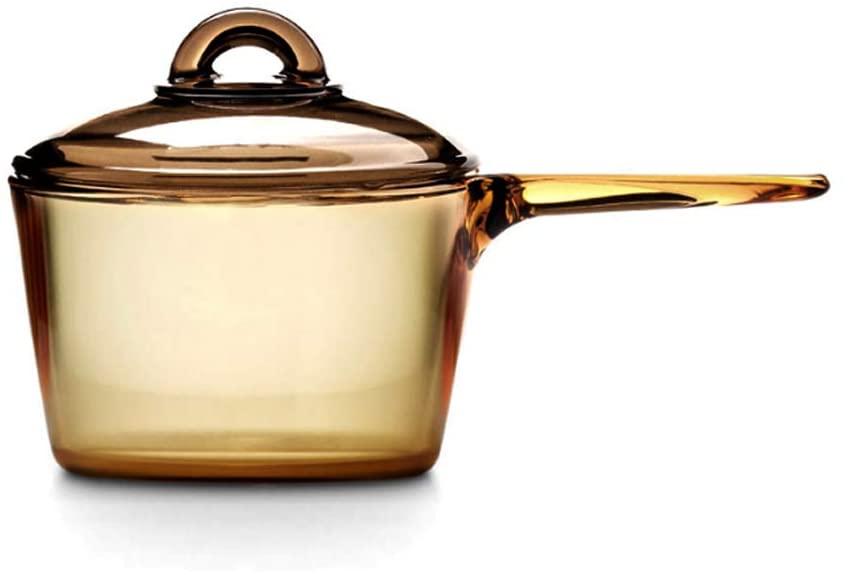
In order to keep on better health, I always use glass-made cookware because there are no residuals of dangerous chemicals leaking into the food.
Luminarc Vitro is made from Vitro-Ceramic, a unique material that is heat resistant and durable which makes cooking much easier as one dish can be used to prepare, cook, serve and store your favorite meals.
Materials used for this Luminarc Vitro are odor-free, stain-free, nickel-free, and does not have any coating that flakes away, 100% food safe and hygienic.
The vitroceramic cookware can be used in the freezer (resistant up to 35’C). This cookware can resist rapid temperature variations up to 450’C.
To cook with Vitro ceramic cookware, we recommend pre-heat at a low temperature for 2 minutes before each use for an even heat distribution.
The vitroceramic material retains heat for a long period of time. It can be used From the freezer to the hob, from oven to table, and also from fridge to microwave.
Vitroceramic is specially used for cooking stews, soups, sauce, water-based recipes, and more.
Before the first use, clean your product in soapy hot water and without any abrasive scourer. After each use, after a short cooling period, set your product aside to cool for a short period, then let it soak in hot soapy water before cleaning.
LUMINARC WHITE 12 PIECE CARINE DINNERWARE SET
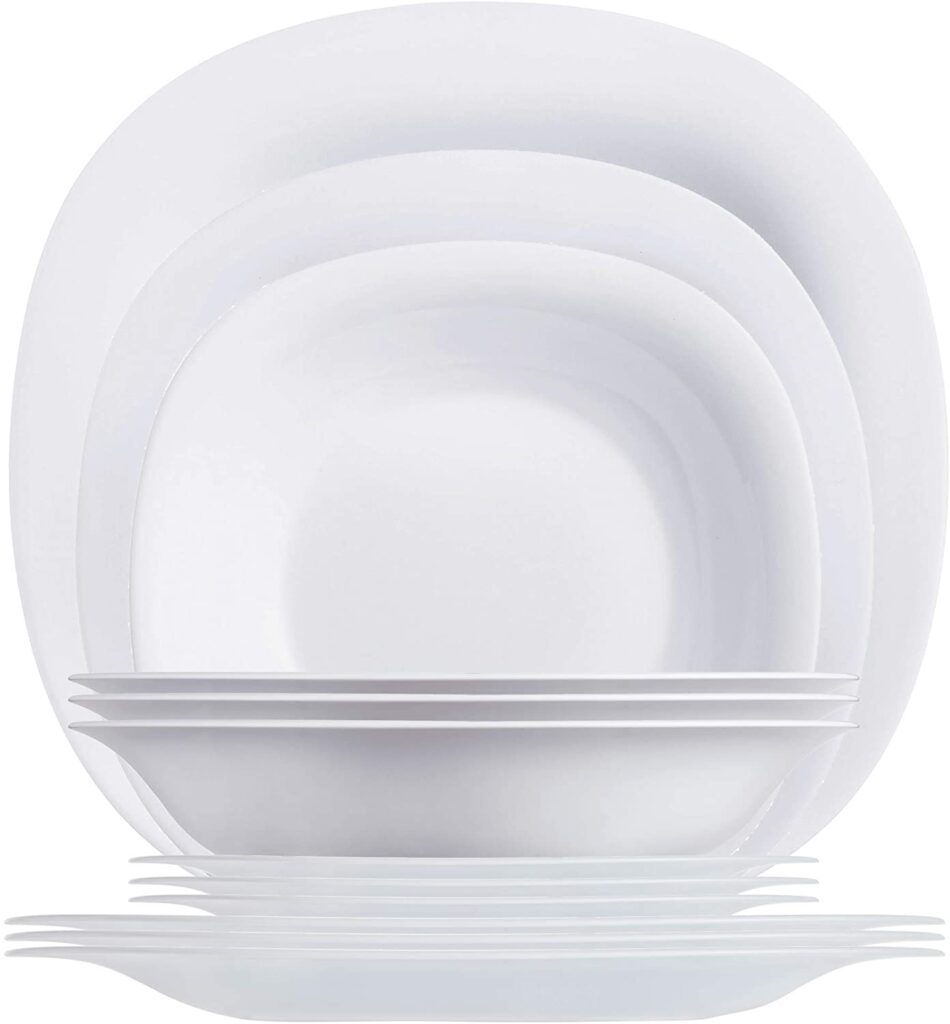
The Luminarc Carine Dinnerware Set is a new timeless classic with its softly rounded square edge for Long-lasting durability.
It is made of Opal tempered glass that is safe for eating and perfect for any table setting.
This set is non-porous, hygienic, lightweight, and stackable for cabinets.
Microwave safe, dishwasher safe, and easy to clean.
CORELLE VS LUMINARC
Corelle sets are made from a unique glass material while Luminarc dinnerware sets are made of Opal tempered glass material.
Corelle sets are made in the USA with 3 years warranty while Luminarc dinnerware sets are made in France. It was introduced in 1958.
Both Corelle and Luminarc sets are non-porous and do not absorb odor, stain, or react with food taste.
READ ALSO: LUMINARC VS CORELLE
READ ALSO: IS FRENCH WHITE CORNINGWARE LEAD-FREE
READ ALSO: IS OPALWARE SAFE FOR HEALTH
IS CORNINGWARE THE SAME AS PYREX
Corningware and Pyrex are made by the same company but have their differences and similarities.
PYREX VS CORNINGWARE
First, the differences between Pyrex vs Corningware
- Pyrex was introduced by 1915 by Corning Inc while Corningware was introduced in 1958 by Corning Glassworks.
- Pyrex is made up of Borosilicate glass, soda-lime glass, stoneware and other materials while Corningware is made up of glass-ceramic (Pyroceram) and stoneware material.
- Pyrex is used for storage while Corningware is for baking.
- The lids of Pyrex are made of plastic BPA free and are while the lids of Corningware are mostly made of Pyrex though most cover are made of borosilicate or tempered soda-lime glass.
The similarities between Pyrex and Corningware
Pyrex and Corningware are both safe in the microwave, oven, and dishwasher.
Pyrex and Corningware are durable kitchenware that can be used from oven to table, refrigerator to the freezer, and even on stovetops or under a broiler, especially the Corningware.
ARCOPAL VS CORELLE
Arcopal and Corelle are both brands that manufacture tableware for use. let’s look into the differences;
Arcopal dinner set is made in French while the Corelle set is made in the USA.
Arcopal dinnerware sets are known to be strong, resistant, and durable while Corelle sets are tempered glass that is resistant against breaks, chips, stains, and scratches.
Arcopal dinnerware is known for its milky white opal glassware which makes childhood memories while Corelle plates and bowls give a touch of elegant experience into indoor and outdoor dining.
CORNINGWARE LEAD WARNING
When it comes to lead poisoning people are really concerned about the health and wellbeing of family and friends.
Health is very important and no one wants to eat or use dishes that will cause threats to the body system.
Inside of Corningware is lead-free.
Lead is used for decoration, in the paint on the outside of Corningware bowls it was tested positive for the lead between 15,000-100,000PPM Lead.
VISION COOKWARE
Vision cookware is a part of glass-ceramic cookware made by the corning company in France and introduced to Europe during the late 1970s.
Vision was made from a type of glass-ceramic (Pygroceram) family and can withstand thermal shock up to 1560 degrees Fahrenheit (850 degrees Celsius).
It can also be used on a gas, electric hob, in the oven, microwave, and even under the grill.
Vision non-porous cookware is one of the safest materials as it does not leach harmful chemicals or substances into the food and also does not absorb odors, stain, or react with acidic food.
VISIONWARE GLASS COOKWARE
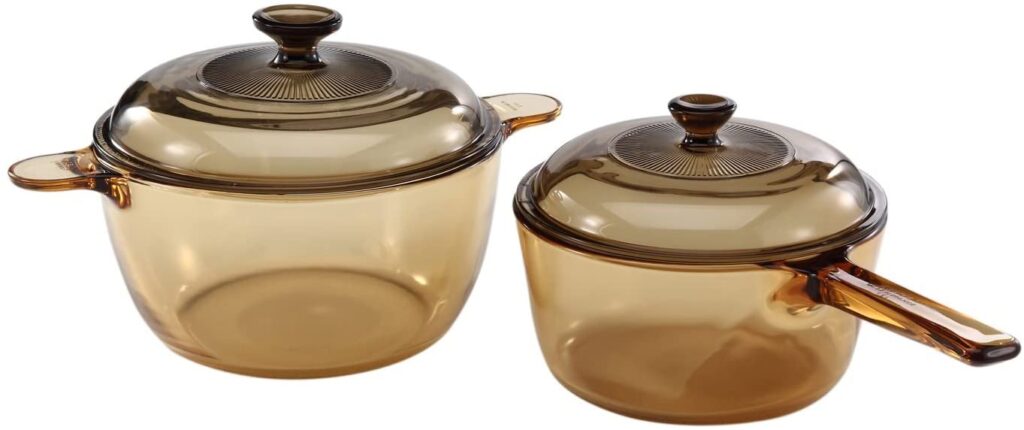
It is made of a non-porous glass-ceramic material that won’t absorb food odors or flavors or react with acid-based foods.
Vision Cookware is designed to see-through for easy monitoring of foods while you cook instead of constantly removing the lid to peep inside.
It works perfectly on a ceramic stovetop and is Ideal for water-based cooking.
Dishwasher-safe; freezer-, microwave-, oven-, broiler-, and stovetop-safe.
The glass handles don’t get hot while cooking. It is constructed for everyday use and does not stick food for super easy to clean.
VISION COOKWARE DISCONTINUED
Why vision cookware was been discontinued, was as a result of a rumor that the cookware used to shatter, leak and explore under heat.
The spread rumors really affected the sales of vision cookware.
VISIONS 5-PC DUTCH OVEN SET
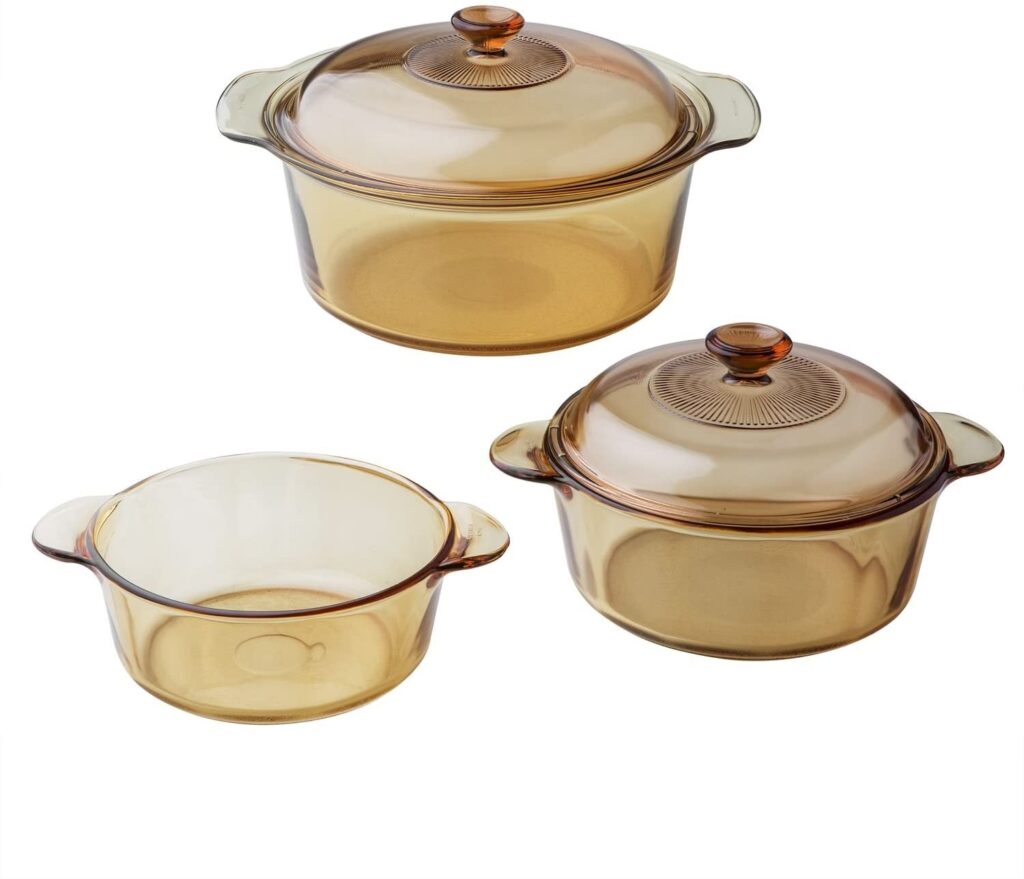
- This Dutch-Oven Dish Set is Resistant to Stains and Does Not Absorb Food Odors or Flavors making it Safe for Cooking on Both Electric and Gas Stovetops.
- The Cookware and Lids are Dishwasher, Freezer, Microwave, Preheated-Oven, Broiler, and Stovetop Safe.
- In this dutch dishes you can Roast, Bake, Broil, Sauté, Serve and Freeze.
CORNINGWARE VS LE CREUSET
Corningware and Le Creuset are high-quality durable dishes known for their cooking performance, strength, and durability.
Corningware was introduced in 1958 while Le Creuset was created in 1925.
Corningware is made of glass-ceramic and stoneware materials while Le Creuset uses the sand casting method to manufacture their cast-iron cookware.
Corningware is resistant to thermal shock while Le Creuset is known for its colorfully- enameled cast iron cookware.
CORELLE VS LUMINARC VS ARCOPAL
Let’s difference between Corelle vs Luminarc vs Arcopal
Corelle sets are lightweight and stackable while Luminarc is a high-quality tempered glass and resistant to break while Arcopal is popular for its milky white opaque appearance.
Corelle set is thinner than most dinnerware sets while Luminarc dinnerware sets don’t contain harmful chemicals while Arcopal sets are made of opal glass.
PYREX CORNINGWARE VINTAGE
Pyrex and Corningware are both manufactured in the United States to bring satisfaction to your kitchen requirement.
Corningware Vintage
Corningware Vintage is made of durable Pyroceramic glass that has a cornflower blue design, great for stove, oven, microwave, refrigerator, and freezer use.
Corningware vintage material is resistant to thermal shock and has good heat resistance for stovetop use.
Pyrex Vintage
Pyrex has created over 150 different Vintage Pyrex patterns and they come in a variety of shapes and sizes.
Pyrex first introduced Opal glass and later migrate to beautiful Vintage colors that add beauty to your kitchen.
The nesting vintage bowls made after the opal glass are stackable, storable for use.
One outstanding feature of Pyrex is that it comes with a mark on the bottom for easy identification.
In 1986 corning glass sold the company to the Corelle brand and they no longer make most of the beautiful collection we love to collect.
Most of the collection Corelle brand manufacture is clear glass with a different look from the old Pyrex vintage that is known.
IS SCRATCHED CORNINGWARE SAFE TO USE?
According to Corningware, the Pyroceram material used in Corningware products can resist stains; do not absorb food odors or flavors. It is also non-porous and will not react with acidic food.
With the above scratch, Corningware is safe to use.
CORNINGWARE CASSEROLE
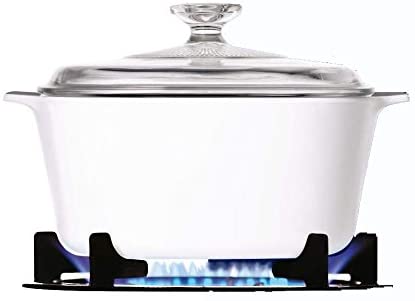
The Corningware casserole is a dish that does it all. It is versatile and suitable for all your preparation, cooking, serving, and storage requirement.
Corningware casserole is capable of withstanding temperature change and thermal shock. The non-porous material is resistant to stains and does not absorb food odors or flavors.
It can be taken straight from the freezer to the oven, microwave, gas, or electric stovetop and then to the dishwasher or sink.
WHAT IS THE DIFFERENCE BETWEEN CORNINGWARE AND CORELLE
1. Corningware was introduced in 1958 by Corning Glassworks while Corelle was introduced in 1970 by Corning.
2. Corningware is made up of glass-ceramic (Pyroceram) and stoneware material while Corelle is made of a special three-layer glass laminate called Vitrelle glass.
3. Corningware dish can be used under the broiler while Corelle dish cannot be used under the broiler.
4. Corningware and Corelle are microwave, oven, refrigerator, freezer, and dishwasher safe.
READ ALSO: WHICH CORELLE DISHES HAVE LEAD
READ ALSO: CAN CORELLE DISHES GO IN THE OVEN
IS CORNINGWARE OVEN-SAFE AT 450 DEGREES?
The product is completely safe at 425 degrees. I spoke with a Corningware representative just to confirm that, and they said there isn’t really a maximum temperature in terms of home use, website says 450, but also read to lower temperature by 25 like any glass dish.
WHAT COMPANY MAKES CORNINGWARE?
In 1958 Corningware was introduced by Corning Glass (Corning International) in the United States and later sold off to the Corning Consumer Products Company (known as the Corelle brand).
Corningware now is sold and distributed under the Corelle brand.
CAN YOU BAKE IN CORNINGWARE?
Corningware is safe to bake with. You can use the Corningware stoneware, Corningware glass-ceramic in a preheated conventional oven, Convection oven, and microwave.
The dishes can also go directly from a refrigerator or freezer into the oven.
READ ALS: CAN ALL CORNINGWARE GO IN THE OVEN
IS CORNINGWARE OVEN-SAFE AT 500 DEGREES?
The original Corningware Pyroceram cookware is safe to put at temperatures exceeding 500 degrees Fahrenheit. The stoneware version of Corningware can also be used in the oven but at a temperature less than 350 degrees Fahrenheit.
READ ALSO: IS FRENCH WHITE CORNINGWARE LEAD-FREE
IS FRENCH WHITE CORNINGWARE OVEN-SAFE?
Yes, French White Corningware is oven safe, microwave safe, dishwasher safe, and can also be used in the refrigerator.
French White Corningware bakeware is baked and served in one dish.
- Carbon Steel Pans for Wood Fired Oven - March 22, 2025
- Cookware for Wood Fired Oven - March 21, 2025
- Cast Iron Dutch Oven Pros and Cons - March 19, 2025